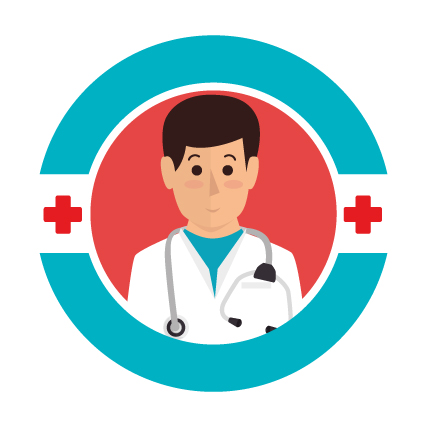
Throat cancer is any cancer that develops within a person’s throat. There are two main types of throat cancer: pharyngeal cancer and laryngeal cancer.
Pharyngeal cancer develops in the pharynx, which is the part of the throat that sits behind the mouth and nasal cavity. Laryngeal cancer develops in the voice box, or larynx. The larynx is a tubular structure that sits at the top of the windpipe.
Throat cancer is not very common in the United States. In fact, according to the National Cancer Institute, pharyngeal cancers — along with oral cancer — account for around 3% of all cancer diagnoses. Laryngeal cancer accounts for around 0.7% of all cancer diagnoses.
Keep reading for more information on the symptoms, signs, and causes of throat cancer. This article also provides information on when to see a doctor.

The early symptoms and signs of throat cancer may vary depending on the part of the throat it affects. However, some general symptoms include:
- A persistent sore throat: This is one of the most common symptoms of throat cancer.
- Difficulty swallowing: Some people may experience a burning sensation or pain in the throat when swallowing. They may also feel that food is becoming stuck in the throat.
- Vocal changes: A person’s voice may become quieter or sound huskier. People may also develop slurred speech or have difficulty pronouncing certain words.
- A lump on the neck: This can indicate a swollen lymph node. Swelling in one or more lymph nodes is a common sign of throat cancer and other cancers of the head and neck.
- Weight loss: This may be related to difficulty swallowing food.
A person with throat cancer may also experience:
It is possible for a person to mistake the signs and symptoms of throat cancer for those of other conditions. A person should therefore see a doctor if they experience any symptoms of throat cancer that do not go away.
Although throat cancers can affect anyone, certain factors can increase the risk of this condition. According to the Memorial Sloan Kettering Cancer Center, some major risk factors include:
Some other risk factors include:
- being over 65 years of age
- being male
- being of Asian ancestry
- having poor nutrition, particularly a lack of fruits and vegetables and overconsumption of processed meats
- having poor dental hygiene
- having exposure to asbestos or coal dust
- having exposure to the Epstein-Barr virus
- having Plummer-Vinson syndrome
- having certain genetic syndromes
Several other conditions can cause symptoms that are similar to those of throat cancer. These conditions include:
A person who is unsure of the cause of their symptoms should see their doctor for a diagnosis.
A person should see their doctor if they experience any of the symptoms of throat cancer for more than 3 weeks.
A doctor will conduct tests to establish whether the symptoms are due to cancer or another cause.
There are several tools a doctor can use to test for throat cancer. They will typically start with a physical examination and a discussion of the person’s symptoms.
If they suspect throat cancer, they may order a laryngoscopy. A laryngoscope is an instrument that allows a doctor to see inside a person’s throat in order to identify any abnormalities.
During a laryngoscopy, the doctor may take a biopsy of the throat tissue. They will then send the tissue sample to a laboratory technician, who will examine it for signs of cancer.
There are three types of biopsy. These are:
- a conventional biopsy, which involves cutting away a piece of the tissue
- an endoscopic biopsy, which involves removing a piece of tissue using a flexible tube, or endoscope, inserted through the mouth
- a fine needle aspiration, which uses a needle to extract cells from a tumor
Cancer staging
If the biopsy returns a positive result for throat cancer, the doctor will assign a stage to it. This stage indicates how advanced the cancer is.
The five stages of throat cancer and their descriptions are as follows:
- Stage 0: Abnormal cells are present within the lining of the throat.
- Stage 1: A tumor is present and measures 2 centimeters (cm) or less. It has not spread to a lymph node.
- Stage 2: The tumor is 2–4 cm. It has not spread to a lymph node.
- Stage 3: The tumor is larger than 4 cm or has spread to a lymph node on the same side of the neck. The affected lymph node is smaller than 3 cm.
- Stage 4: The cancer has spread to several lymph nodes or to other tissues and organs within the body.
Throat cancer is a rare type of cancer that develops in a small percentage of people each year.
Anyone can develop throat cancer, but people who are older, male, or of Asian ancestry are at increased risk.
Throat cancer is not always preventable. However, there are some steps a person can take to reduce their risk of developing it. These include eating a healthful diet, quitting smoking, and avoiding excessive alcohol consumption.
A person should see their doctor if they experience any symptoms of throat cancer for longer than 3 weeks.
Related Post
 24
24 Oct
When Does Nutex health Inc Do Earnings Report Come Out?
When Does Nutex health Inc Do Earnings Report Come Out? Today announced that Nutex Health Inc., Nutex Health" or the "Company," a physician-led, integrated healthcare delivery system comprising of 21 state-of- the-art micro hospitals in 9 states and primary care-centric. The.
Read More 16
16 Sep
The Role of Lifestyle in Anti-Aging Skin Care Products
Looking for anti aging skin care products can feel like a hit-or-miss insight. With so many options, it can be hard to choose. These dermatologist tips can assist you with shopping with certainty. Has your skin been harmed or has it matured altogether.
Read More 14
14 Aug
7 Essential Healthy Habits to Instill in Your Kids in 2024
In the high-speed universe of 2024, raising solid and balanced kids requires a blend of shrewd nurturing and adjusting to the most recent patterns. As guardians, it's critical to instill propensities that cultivate both physical and mental prosperity in our.
Read More 29
29 Jul
Which Symptom Indicates That Someone May Need Mental Health Treatment?
Today! In this article!, you can find the best treatment for mental health. Which symptom indicates that someone may need mental health treatment? Perceive the indications of requiring emotional well-being treatment and assume responsibility for your prosperity. Try not to hold.
Read More